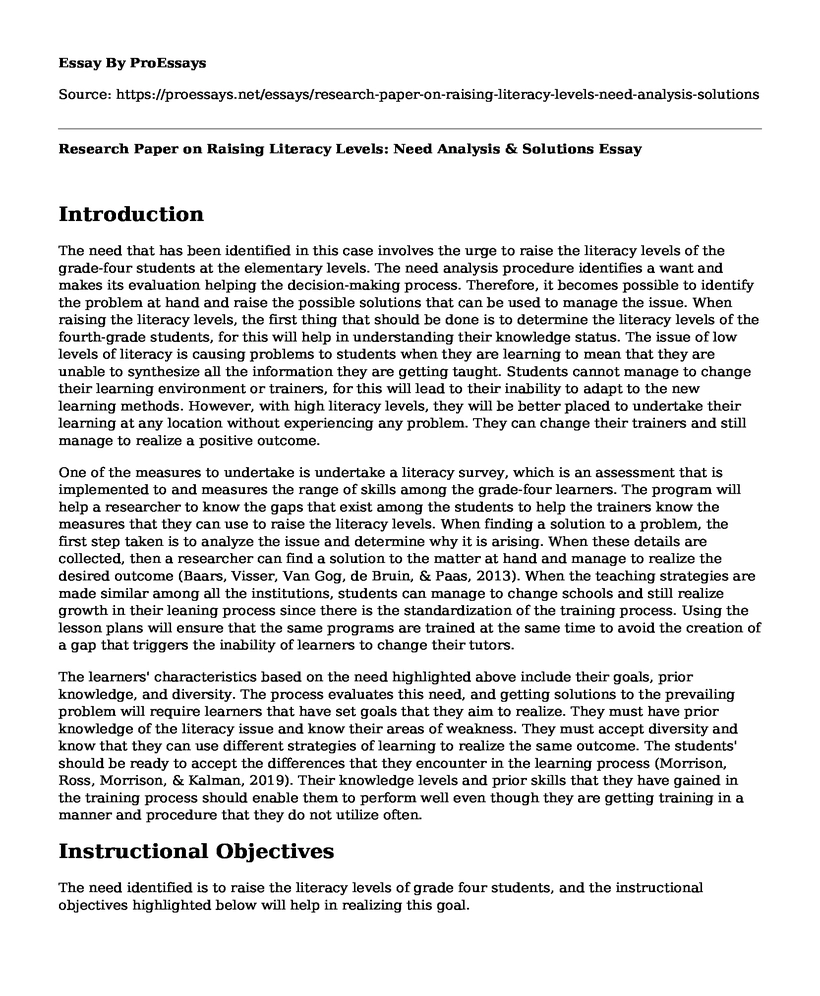Introduction
The need that has been identified in this case involves the urge to raise the literacy levels of the grade-four students at the elementary levels. The need analysis procedure identifies a want and makes its evaluation helping the decision-making process. Therefore, it becomes possible to identify the problem at hand and raise the possible solutions that can be used to manage the issue. When raising the literacy levels, the first thing that should be done is to determine the literacy levels of the fourth-grade students, for this will help in understanding their knowledge status. The issue of low levels of literacy is causing problems to students when they are learning to mean that they are unable to synthesize all the information they are getting taught. Students cannot manage to change their learning environment or trainers, for this will lead to their inability to adapt to the new learning methods. However, with high literacy levels, they will be better placed to undertake their learning at any location without experiencing any problem. They can change their trainers and still manage to realize a positive outcome.
One of the measures to undertake is undertake a literacy survey, which is an assessment that is implemented to and measures the range of skills among the grade-four learners. The program will help a researcher to know the gaps that exist among the students to help the trainers know the measures that they can use to raise the literacy levels. When finding a solution to a problem, the first step taken is to analyze the issue and determine why it is arising. When these details are collected, then a researcher can find a solution to the matter at hand and manage to realize the desired outcome (Baars, Visser, Van Gog, de Bruin, & Paas, 2013). When the teaching strategies are made similar among all the institutions, students can manage to change schools and still realize growth in their leaning process since there is the standardization of the training process. Using the lesson plans will ensure that the same programs are trained at the same time to avoid the creation of a gap that triggers the inability of learners to change their tutors.
The learners' characteristics based on the need highlighted above include their goals, prior knowledge, and diversity. The process evaluates this need, and getting solutions to the prevailing problem will require learners that have set goals that they aim to realize. They must have prior knowledge of the literacy issue and know their areas of weakness. They must accept diversity and know that they can use different strategies of learning to realize the same outcome. The students' should be ready to accept the differences that they encounter in the learning process (Morrison, Ross, Morrison, & Kalman, 2019). Their knowledge levels and prior skills that they have gained in the training process should enable them to perform well even though they are getting training in a manner and procedure that they do not utilize often.
Instructional Objectives
The need identified is to raise the literacy levels of grade four students, and the instructional objectives highlighted below will help in realizing this goal.
Cognitive: The students will be needed to engage their mental ability, senses, experience, and thoughts to acquire knowledge. The process will enable them to raise their understanding levels and the ability to synthesis the learned knowledge.
Behaviors: The learners will be expected to adopt mannerism that will offer them a platform to acquire knowledge and manage to work in new systems.
Affective: The learners will be expected to work optimally towards the realization of the high literacy levels and work towards overcoming the hurdles that may arise when undertaking the process.
References
Baars, M., Visser, S., Van Gog, T., de Bruin, A., & Paas, F. (2013). Completion of partially worked-out examples as a generation strategy for improving monitoring accuracy. Contemporary Educational Psychology, 38(4), 395-406. doi.org/10.1016/j.cedpsych.2013.09.001
Morrison, G. R., Ross, S. J., Morrison, J. R., & Kalman, H. K. (2019). Designing effective instruction. John Wiley & Sons.
Cite this page
Research Paper on Raising Literacy Levels: Need Analysis & Solutions. (2023, Mar 28). Retrieved from https://proessays.net/essays/research-paper-on-raising-literacy-levels-need-analysis-solutions
If you are the original author of this essay and no longer wish to have it published on the ProEssays website, please click below to request its removal:
- Letter on Difference in Traditions Between America and India
- The Variance in Phonics and Phonemic Awareness Essay
- Children Left Behind: Effects of Incarceration on Children Paper Example
- Questions and Answers on Gun Violence at Harper High School Paper Example
- Essay on Teaching & Learning: Two Intertwined Processes for Effective Communication
- Early Childhood Education: Allocating Funds for Disadvantaged Kids - Essay Sample
- Essay Exampe on Bullying Among Children: Power and Social Status Dynamics







